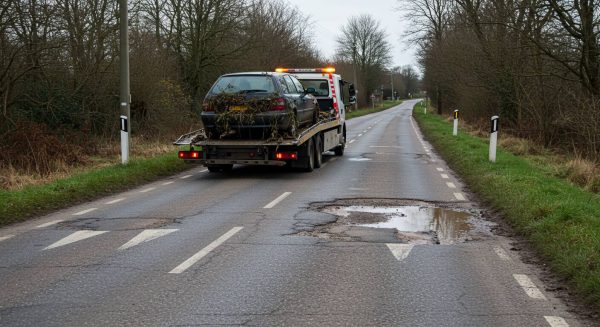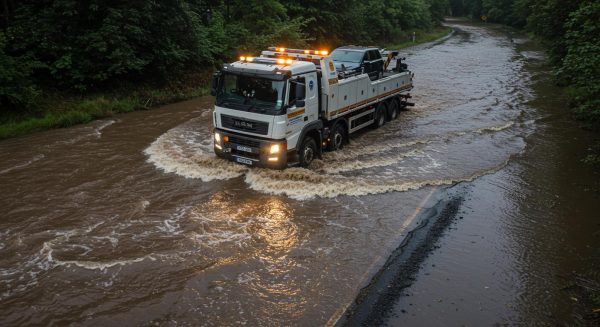The dangers of driving through flood water cannot be overstated. The AA reports that driving through flood water is the leading cause of flood-related deaths in the UK, yet every year recovery operators are called to assist motorists who have attempted to navigate flooded roads.

Electric Car Safety in Floods
Electric vehicle owners face additional considerations when encountering flooded roads. While modern electric vehicles are designed with sealed battery units, driving through deep water risks serious damage to electrical systems. Tesla and other manufacturers typically advise against driving through water that’s deeper than the bottom of the vehicle’s body. If an electric vehicle becomes stranded in flood water, specialist recovery is essential due to the high-voltage systems involved.
General Guidelines for All Vehicles
The following key points can help drivers make safe decisions when encountering flood water:
Depth Assessment
Never attempt to drive through water if you cannot see the road surface beneath. As a rule of thumb, if the water reaches the bottom of your car’s doors (typically around 30 cm), it’s too deep to drive through safely. Moving water is even more dangerous—the AA warns that just 30 cm of flowing water can float a car.
If You Must Drive Through Shallow Water
If you encounter shallow standing water (less than 10 cm) and have no alternative route:
- Drive in the middle of the road where possible, as this is usually the highest point.
- Maintain a steady, slow speed (around 4-5 mph) to avoid creating a bow wave.
- Keep engine revs high by using a lower gear.
- Do not stop—water can be drawn into the exhaust.
- Test your brakes immediately after emerging from the water.
When to Call for Recovery
If your vehicle becomes stranded in flood water:
- Stay with your vehicle if safe to do so.
- Call for professional recovery. Do not attempt self-recovery.
- Switch off the engine immediately to prevent water ingress.
- Turn on hazard lights to warn other motorists.
- Call your insurance company as soon as possible.
Prevention and Planning
Before travelling in wet conditions:
- Check weather forecasts and flood warnings.
- Plan alternative routes, avoiding flood-prone areas.
- Ensure your breakdown cover includes flood recovery.
- Keep emergency contact numbers handy.
- Consider postponing nonessential journeys if severe weather is forecast.
Remember that attempting to drive through flood water not only risks your safety but may also invalidate your insurance. The safest approach is always to find an alternative route or wait until floodwaters subside.
If recovery is needed, professional operators have specialist equipment and expertise to safely extract vehicles from flood water. The cost of professional recovery is significantly less than the potential damage to your vehicle from attempting to drive through floods or self-recover.

